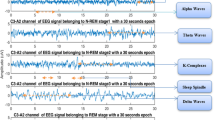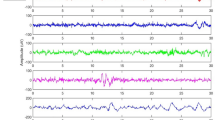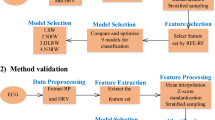Abstract
Research has demonstrated a significant overlap between sleep issues and other medical conditions. In this paper, we consider mild difficulty in falling asleep (MDFA). Recognition of MDFA has the potential to assist in the provision of appropriate treatment plans for both sleep issues and related medical conditions. An issue in the diagnosis of MDFA lies in subjectivity. To address this issue, a decision support tool based on dual-modal physiological feature fusion which is able to automatically identify MDFA is proposed in this study. Special attention is given to the problem of how to extract candidate features and fuse dual-modal features. Following the identification of the optimal feature set, this study considers the correlations between each feature and class and evaluates correlations between the inter-modality features. Finally, the recognition accuracy was measured using 10-fold cross validation. The experimental results for our method demonstrate improved performance. The highest recognition rate of MDFA using the optimal feature set can reach 96.22%. Based on the results of current study, the authors will, in projected future research, develop a real-time MDFA recognition system.
Similar content being viewed by others
Explore related subjects
Discover the latest articles, news and stories from top researchers in related subjects.References
K. J. Horsley, C. R. Rouleau, S. N. Garland, C. Samuels, S. G. Aggarwal, J. A. Stone, R. Arena, T. S. Campbell. Insomnia symptoms and heart rate recovery among patients in cardiac rehabilitation. Journal of Behavioral Medicine, vol. 39, no. 4, pp. 642–651, 2016. DOI: https://doi.org/10.1007/s10865-016-9725-y.
M. W. Johns. A new method for measuring daytime sleepiness: The Epworth sleepiness scale. Sleep, vol. 14, no. 6, pp. 540–545, 1991. DOI: https://doi.org/10.1093/sleep/14.6.540.
A. J. Stunkard, M. S. Faith, K. C. Allison. Depression and obesity. Biological Psychiatry, vol. 54, no. 3, pp. 330–337, 2003. DOI: https://doi.org/10.1016/S0006-3223(03)00608-5.
E. E. Tripoliti, D. I. Fotiadis, M. Argyropoulou. A supervised method to assist the diagnosis and monitor progression of Alzheimer’s disease using data from an fMRI experiment. Artificial Intelligence in Medicine, vol. 53, no. 1, pp. 35–45, 2011. DOI: https://doi.org/10.1016/j.artmed.2011.05.005.
T. P. Exarchos, A. T. Tzallas, D. Baga, D. Chaloglou, D. I. Fotiadis, S. Tsouli, M. Diakou, S. Konitsiotis. Using partial decision trees to predict Parkinson’s symptoms: A new approach for diagnosis and therapy in patients suffering from Parkinson’s disease. Computers in Biology and Medicine, vol. 42, no. 2, pp. 195–204, 2012. DOI: https://doi.org/10.1016/j.compbiomed.2011.11.008.
M. M. Ohayon. Epidemiology of insomnia: What we know and what we still need to learn. Sleep Medicine Reviews, vol. 6, no. 2, pp. 97–111, 2002. DOI: https://doi.org/10.1053/smrv.2002.0186.
A. Ylikoski, K. Martikainen, M. Sieminski, M. Partinen. Sleeping difficulties and health-related quality of life in Parkinson’s disease. Acta Neurologica Scandinavica, vol. 135, no. 4, pp. 459–468, 2017. DOI: https://doi.org/10.1111/ane.12620.
A. Bellatorre, K. Choi, D. Lewin, D. Haynie, B. Simons-Morton. Relationships between smoking and sleep problems in black and white adolescents. Sleep, vol. 40, no. 1, Article number zsw031, 2017. DOI: https://doi.org/10.1093/sleep/zsw031.
A. A. Gamaldo, J. C. Allaire, K. E. Whitfield. The relationship between reported problems falling asleep and cognition among African American elderly. Research on Aging, vol. 30, no. 6, pp. 752–767, 2008. DOI: https://doi.org/10.1177/0164027508322576.
W. C. Choo, W. W. Lee, V. Venkatraman, F. S. Sheu, M. W. L. Chee. Dissociation of cortical regions modulated by both working memory load and sleep deprivation and by sleep deprivation alone. Neuroimage, vol. 25, no. 2, pp. 579–587, 2005. DOI: https://doi.org/10.1016/j.neuroimage.2004.11.029.
L. Leigh, I. L. Hudson, J. E. Byles. Sleeping difficulty, disease and mortality in older women: A latent class analysis and distal survival analysis. Journal of Sleep Research, vol. 24, no. 6, pp. 648–657, 2015. DOI: https://doi.org/10.1111/jsr.12324.
O. P. Almeida, H. Alfonso, B. B. Yeap, G. Hankey, L. Flicker. Complaints of difficulty to fall asleep increase the risk of depression in later life: The health in men study. Journal of Affective Disorders, vol. 134, no. 1–3, pp. 208–216, 2011. DOI: https://doi.org/10.1016/j.jad.2011.05.045.
J. D. Edinger, M. H. Bonnet, R. R. Bootzin, K. Doghramji, C. M. Dorsey, C. A. Espie, A. O. Jamieson, W. V. McCall, C. M. Morin, E. J. Stepanski. Derivation of research diagnostic criteria for insomnia: Report of an American academy of sleep medicine work group. Sleep, vol. 27, no. 8, pp. 1567–1596, 2004. DOI: https://doi.org/10.1093/sleep/27.8.1567.
C. M. Jung, J. M. Ronda, C. A. Czeisler, K. P. Jr. Wright. Comparison of sustained attention assessed by auditory and visual psychomotor vigilance tasks prior to and during sleep deprivation. Journal of Sleep Research, vol. 20, no. 2, pp. 348–355, 2011. DOI: https://doi.org/10.1111/j.1365-2869.2010.00877.x.
S. W. Lockley, E. E. Evans, F. A. Scheer, G. C. Brainard, C. A. Czeisler, D. Aeschbach. Short-wavelength sensitivity for the direct effects of light on alertness, vigilance, and the waking electroencephalogram in humans. Sleep, vol. 29, no. 2, pp. 161–168, 2006. DOI: https://doi.org/10.1093/sleep/29.2.161.
B. T. Zhang, T. Lei, H. Liu, H. S. Cai. EEG-based automatic sleep staging using ontology and weighting feature analysis. Computational and Mathematical Methods in Medicine, vol. 2018, Article number 6534041, 2018. DOI: https://doi.org/10.1155/2018/6534041.
S. Kinreich, I. Podlipsky, S. Jamshy, N. Intrator, T. Hendler. Neural dynamics necessary and sufficient for transition into pre-sleep induced by EEG neurofeedback. Neuroimage, vol. 97, pp. 19–28, 2014. DOI: https://doi.org/10.1016/j.neuroimage.2014.04.044.
W. Dement, N. Kleitman. Cyclic variations in EEG during sleep and their relation to eye movements, body motility, and dreaming. Electroencephalography and Clinical Neurophysiology, vol. 9, no. 4, pp. 673–690, 1957. DOI: https://doi.org/10.1016/0013-4694(57)90088-3.
S. F. Liang, C. E. Kuo, F. Z. Shaw, Y. H. Chen, C. H. Hsu, J. Y. Chen. Combination of expert knowledge and a genetic fuzzy inference system for automatic sleep staging. IEEE Transactions on Biomedical Engineering, vol. 63, no. 10, pp. 2108–2118, 2016. DOI: https://doi.org/10.1109/TBME.2015.2510365.
O. Tsinalis, P. M. Matthews, Y. K. Guo. Automatic sleep stage scoring using time-frequency analysis and stacked sparse autoencoders. Annals of Biomedical Engineering, vol. 44, no. 5, pp. 1587–1597, 2016. DOI: https://doi.org/10.1007/s10439-015-1444-y.
B. Sen, M. Peker, A. Cavusoglu, F. V. Celebi. A comparative study on classification of sleep stage based on EEG signals using feature selection and classification algorithms. Journal of Medical Systems, vol. 38, no. 3, pp. 667–687, 2014. DOI: https://doi.org/10.1007/s10916-014-0018-0.
Y. L. Hsu, Y. T. Yang, J. S. Wang, C. Y. Hsu. Automatic sleep stage recurrent neural classifier using energy features of EEG signals. Neurocomputing, vol. 104, pp. 105–114, 2013. DOI: https://doi.org/10.1016/j.neucom.2012.11.003.
S. F. Liang, C. E. Kuo, Y. H. Hu, Y. H. Pan, Y. H. Wang. Automatic stage scoring of single-channel sleep EEG by using multiscale entropy and autoregressive models. IEEE Transactions on Instrumentation and Measurement, vol. 61, no. 6, pp. 1649–1657, 2012. DOI: https://doi.org/10.1109/TIM.2012.2187242.
H. Akaike. Fitting autoregressive models for prediction. Annals of the Institute of Statistical Mathematics, vol. 21, no. 1, pp. 243–247, 1969. DOI: https://doi.org/10.1007/BF02532251.
I. J. Rampil. A primer for EEG signal processing in anesthesia. Anesthesiology, vol. 89, no. 4, pp. 980–1002, 1998. DOI: https://doi.org/10.1097/00000542-199810000-00023.
T. Cecchin, R. Ranta, L. Koessler, O. Caspary, H. Vespignani, L. Maillard. Seizure lateralization in scalp EEG using Hjorth parameters. Clinical Neurophysiology, vol. 121, no. 3, pp. 290–300, 2010. DOI: https://doi.org/10.1016/j.clinph.2009.10.033.
Z. Y. Huang, H. Y. Zhu, J. T. Zhou, X. Peng. Multiple marginal fisher analysis. IEEE Transactions on Industrial Electronics, to be published. DOI: https://doi.org/10.1109/TIE.2018.2870413.
T. Lei, X. H. Jia, Y. N. Zhang, L. F. He, H. Y. Meng, A. K. Nandi. Significantly fast and robust fuzzy C-means clustering algorithm based on morphological reconstruction and membership filtering. IEEE Transactions on Fuzzy Systems, vol. 26, no. 5, pp. 3027–3041, 2018. DOI: https://doi.org/10.1109/TFUZZ.2018.2796074.
M. A. Hall. Correlation-based Feature Selection for Machine Learning, Ph. D. dissertation, The University of Waikato, New Zealand, 1999.
A. Cutler, D. R. Cutler, J. R. Stevens. Random forests. In Ensemble Machine Learning, C. Zhang, Y. Q. Ma, Eds., Boston, USA: Springer, pp. 157–176, 2004.
S. Lee. Using Weka in Matlab, [Online], Available: https://cn.mathworks.com/matlabcentral/fileexchange/5 0120-using-weka-in-matlab, January 20, 2019.
L. Fraiwan, K. Lweesy, N. Khasawneh, H. Wenz, H. Dickhaus. Automated sleep stage identification system based on time-frequency analysis of a single EEG channel and random forest classifier. Computer Methods and Programs in Biomedicine, vol. 108, no. 1, pp. 10–19, 2012. DOI: https://doi.org/10.1016/j.cmpb.2011.11.005.
A. L. Goldberger, L. A. N. Amaral, L. Glass, J. M. Hausdorff, P. C. Ivanov, R. G. Mark, J. E. Mietus, G. B. Moody, C. K. Peng, H. E. Stanley. PhysioBank, physiotoolkit, and physionet: Components of a new research resource for complex physiologic signals. Circulation, vol. 101, no. 23, pp. E215–E220, 2000.
L. Zoubek, S. Charbonnier, S. Lesecq, A. Buguet, F. Chapotot. Feature selection for sleep/wake stages classification using data driven methods. Biomedical Signal Processing and Control, vol. 2, no. 3, pp. 171–179, 2007. DOI: https://doi.org/10.1016/j.bspc.2007.05.005.
S. A. Imtiaz, Z. Jiang, E. Rodriguez-Villegas. An ultralow power system on chip for automatic sleep staging. IEEE Journal of Solid-State Circuits, vol. 52, no. 3, pp. 822–833, 2017. DOI: https://doi.org/10.1109/JSSC.2017.2647923.
M. Diykh, Y. Li. Complex networks approach for EEG signal sleep stages classification. Expert Systems with Applications, vol. 63, pp. 241–248, 2016. DOI: https://doi.org/10.1016/j.eswa.2016.07.004.
J. A. Hobson. A manual of standardized terminology, techniques and scoring system for sleep stages of human subjects: A. Rechtschaffen and A. Kales (Editors). Electroencephalography and Clinical Neurophysiology, vol. 26, no. 6, Article number 644, 1969.
C. Iber, S. Ancoli-Israel, A. L. Jr. Chesson, S. F. Quan. The AASM Manual for the Scoring of Sleep and Associated Events: Rules, Terminology and Technical Specifications, Westchester, USA: American Academy of Sleep Medicine, 2007.
I. Kononenko. Estimating attributes: Analysis and extesions of RELIEF. In Proceedings of European Conference on Machine Learning on Machine Learning, Springer, Catania, Italy, pp. 171–182, 1994.
J. Tang, S. Alelyani, H. Liu. Feature selection for classification: A review. Data Classification: Algorithms and Applications, vol. 98, no. 7, pp. 313–334, 2014.
M. Schwartz, M. Park, J. H. Phan, M. D. Wang. Integration of multimodal RNA-seq data for prediction of kidney cancer survival. In Proceedings of IEEE International Conference on Bioinformatics and Biomedicine, Washington, USA, pp. 1591–1595, 2015. DOI: https://doi.org/10.1109/BIBM.2015.7359913.
M. Goudjil, M. Koudil, M. Bedda, N. Ghoggali. A novel active learning method using SVM for text classification. International Journal of Automation and Computing, vol. 15, no. 3, pp. 290–298, 2018. DOI: https://doi.org/10.1007/s11633-015-0912-z.
C. L. Zhang, Y. P. Xu, Z. J. Xu, J. He, J. Wang, J. H. Adu. A fuzzy neural network based dynamic data allocation model on heterogeneous multi-GPUs for large-scale computations. International Journal of Automation and Computing, vol. 15, no. 2, pp. 181–193, 2018. DOI: https://doi.org/10.1007/s11633-018-1120-4.
M. L. Green, P. D. Karp. A Bayesian method for identifying missing enzymes in predicted metabolic pathway databases. BMC Bioinformatics, vol. 5, Article number 76, 2004. DOI: https://doi.org/10.1186/1471-2105-5-76.
A. A. B. Subramanian, S. Pramala, B. Rajalakshmi, R. Rajaram. Improving decision tree performance by exception handling. International Journal of Automation and Computing, vol. 7, no. 3, pp. 372–380, 2010. DOI: https://doi.org/10.1007/s11633-010-0517-5.
X. W. Zhang, B. Hu, X. Ma, L. X. Xu. Resting-state whole-brain functional connectivity networks for MCI classification using L2-regularized logistic regression. IEEE Transactions on Nanobioscience, vol. 14, no. 2, pp. 237–247, 2015. DOI: https://doi.org/10.1109/TNB.2015.2403274.
H. Y. Zhu, R. Vial, S. J. Lu, X. Peng, H. Z. Fu, Y. H. Tian, X. B. Cao. Yotube: Searching action proposal via recurrent and static regression networks. IEEE Transactions on Image Processing, vol. 27, no. 6, pp. 2609–2622, 2018. DOI: https://doi.org/10.1109/TIP.2018.2806279.
M. Shahin, B. Ahmed, S. T. B. Hamida, F. L. Mulaffer, M. Glos, T. Penzel. Deep learning and insomnia: Assisting clinicians with their diagnosis. IEEE Journal of Biomedical and Health Informatics, vol. 21, no. 6, pp. 1546–1553, 2017. DOI: https://doi.org/10.1109/JBHI.2017.2650199.
M. Shahin, L. Mulaffer, B. Ahmed. Two Stages Approach for Automatic Detection of Sleep Insomnia, [Online], Available: https://www.researchgate.net/publication/324330830_Two_Stages_Approach_for_Automatic_Detection_of_Sleep_Insomnia, 2018.
B. Hu, D. Majoe, M. Ratcliffe, Y. B. Qi, Q. L. Zhao, H. Peng, D. P. Fan, F. Zheng, M. Jackson, P. Moore. EEG-based cognitive interfaces for ubiquitous applications: Developments and challenges. IEEE Intelligent Systems, vol. 26, no. 5, pp. 46–53, 2011. DOI: https://doi.org/10.1109/MIS.2011.58.
Acknowledgements
This work has been supported by National Natural Science Foundation of China (Nos. 61761027 and 61461025), the Yong Scholar Fund of Lanzhou Jiaotong University (No. 2016004) and the Teaching Reform Project of Lanzhou Jiaotong University (No. JGY201841).
Author information
Authors and Affiliations
Corresponding author
Additional information
Recommended by Associate Editor Hong Qiao
Bing-Tao Zhang received the M. Sc. degree in computer software and theory from Lanzhou University of Technology, China in 2011. He is currently a Ph. D. degree candidate in computer application at Lanzhou University. Since 2014, he has been a lecturer with the School of Electronic and Information Engineering, Lanzhou Jiaotong University, China.
His research interests include the intersection between computer science and sleep staging, data mining, ontology-based knowledge base modeling of multimodal physiological signals.
Xiao-Peng Wang received the Ph. D. degree in signal and information processing from Northwestern Polytechnical University, China in 2005. He has published about 80 papers in peer reviewed journals and conferences.
His research interests include intelligent information processing and computer application.
Yu Shen received the Ph. D. degree in intelligent transportation and information system engineering from Lanzhou Jiaotong University, China in 2017. She has published about 40 papers in peer reviewed journals and conferences.
Her research interests include digital image processing and communication and information system engineering.
Tao Lei received the Ph. D. degree in information and communication engineering from Northwestern Polytechnical University, China in 2011. He has published about 70 papers in peer reviewed journals and conferences including Image and Vision Computing, IET Image Processing, Science China Information Sciences, Multimedia Tools and Applications, etc.
His research interests include pattern recognition and artificial intelligence.
Rights and permissions
About this article
Cite this article
Zhang, BT., Wang, XP., Shen, Y. et al. Dual-modal Physiological Feature Fusion-based Sleep Recognition Using CFS and RF Algorithm. Int. J. Autom. Comput. 16, 286–296 (2019). https://doi.org/10.1007/s11633-019-1171-1
Received:
Accepted:
Published:
Issue Date:
DOI: https://doi.org/10.1007/s11633-019-1171-1




